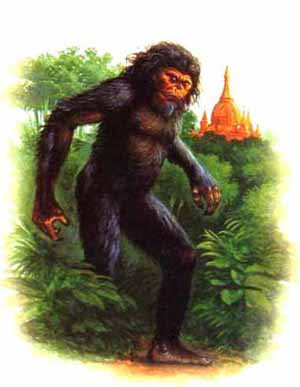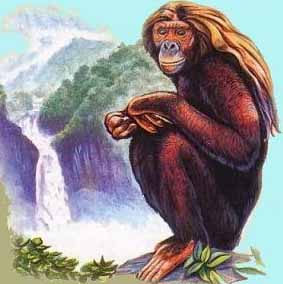The Yeti:
 |
| A Yeti type creature walking up a mountain |
The Yeti, depending on the area you are in, ha many names:
Michê (Tibetan: མི་དྲེད་, Wylie: mi dred, ZYPY: Michê) translates as "man-bear".
Dzu-teh – 'dzu' translates as "cattle" and the full meaning translates as "cattle bear", referring to the Himalayan brown bear
Migoi or Mi-go (Tibetan: མི་རྒོད་, Wylie: mi rgod, ZYPY: Migö/Mirgö) translates as "wild man".
Bun Manchi - Nepali for "jungle man" that is used outside Sherpa communities where yeti is the common name.
Mirka – another name for "wild-man". Local legend holds that "anyone who sees one dies or is killed". The latter is taken from a written statement by Frank Smythe's sherpas in 1937.
Kang Admi – "Snow Man".
Descriptions on the Yeti vary mainly in height leading researchers too believe that the larger creatures sighted are more adult creatures, not a separate species.
Mande Barung:
 |
| Artists impression of Mande Barung |
Generally described as a large, hairy bipedal hominid, some believe that this animal, or its close relatives, may be found around the world under different regional names, such as the Yeti of Tibet and Nepal, the Ban-manush in Bangladesh, the Yeren of mainland China, and the Bigfoot of the Pacific northwest region of the United States and the Canadian province of British Columbia.
The Mande Barung is known through out India for its violence towards Humans and in Indian legend and folklore the Mande Barung is regarded as the guardian of the forest.
The Yeren:
 |
| A model of the Yeren |
The creature is said to stand an average of six and a half feet tall and to be covered in thick brown or red hair. It is bi-pedal and has a hefty abdominal region as well as an ape-like muzzle, large ears and eyes like that of a human, leaving behind large footprints, up to sixteen inches long, with five toes, four small toes held close together and a larger toe that points outward slightly.
According to Chinese folklore, the creature eats people. Coming across a human, it grips his or her arms tightly, making escape impossible. It is apparently so overjoyed by trapping its prey that it faints with mirth - but without losing its hold. When it returns to its senses, it kills and eats its victim. Thus travelers in the mountains were advised to wear a pair of hollow bamboo cylinders on their arms. If a Wildman caught them, they could then, while the creature was in swoon, slip their arms out of the cylinders and escape. Reports of the creature go back to as far as 2000 years.
The Almas/Relic Neanderthal:
NO IMAGES EXIST!
The Almas is perhaps the most amazing Man-like wildman ever reported because of the fact their have been many reports of Almas-human interaction and interbreeding! It its mainly reported in Russia, Kazakhstan and Mongolia where it is described as terrified of Homo Sapiens and can take months for one too trust someone enough too come close enough for a close look.Loud noises are said too scare them. They are often reported as fury or hairless wearing ice-age clothing.
Also known as Almasty and Albasty these strange apelike creatures, allegedly resembling Neanderthal man.
In the Caucasus, Almas (which in the Mongolian language means 'wildman') are well known by the local people, who tell numerous stories of an apparent familiarity between humans and these creatures. Eyewitness accounts dating back hundreds of years describe Almas communicating with humans by means of gestures. There were even stories of Almas bartering food for trinkets.
Adult Almases have been described as being at least 5 ft tall, shy, hairy, with prominent eyebrow ridges, a receding chin and a jaw that protrudes out.
Other names by which these creatures are known, depending on the particular region, are 'Wind-Man', Abnuaaya, Bekk-Bok, Biabin-Guli, Gul-Biavan, Guli-Avan, Golub-Yavan, Kaptar, Kra-Dhan, Ksy-Giik or Ksy Gyik, Mirygdy, Mulen and Voita.
The Meh-Teh:
 |
| A Artists impression of the Meh-Teh |
The Meh-Teh ("man-beast") is a possible subspecies of Yeti supposedly proportioned more like a hairy heavy set man (but it leaves a most unhuman type of footprint), and the Dzu-Teh like a gigantic ape-man. Another type of Yeti (pygmy size) is called Teh-lma.
The Meh-Teh is allegedly a very bestial and shy type of hairy hominid, with a animal-like behavior and thick reddish-brown to black fur, a conical head, stout neck, wide mouth with no lips, and long arms which reach almost to its knees, supposedly inhabiting the Tibetan upper plateau forests. Its five-toed feet are short and very broad, with a second toe longer than the big toe.
The Chuchunaa:
| Artists impression of the Chucchunaa |
Chuchunaa is Siberia's Bigfoot. The Chuchunaa were reported by a branch of the Soviet Academy of Science as recently as the 1950s in the bitterly cold and forbidding region of northeast Siberia, who speculated that they might represented the last surviving remnants of paleo-asiatic aborigines that retreated to the upper reaches of the Yana and Indigirka rivers.
These people are said to have an extremely limited range of oral sound. This may have been a genetic mutation - or is it an indication of these people's Neanderthal origin?
The Chuchunaa are described as being very tall with a protruding brow and long matted hair, usually sporting some type of animal skin covering. Locals swear it is a man-eater. Recent reports suggest that they have withdrawn to even more remote areas away from encroaching civilization.
The Higabon:
The Nguoi Rung:
 |
| Artists impression of the Nguoi Rung |
The Nguoirung is also known as the Vietnamese Wildman, or "Forest People". Appearance and legends are similar as for the Wildman of China; it is described as being approximately six feet tall and completely covered with hair except for the knees, the soles of the feet, the hands and the face. The hair ranges in color from gray to brown to black. The creature walks on two legs and has been reported seen both solitary and moving in small clans.
Along the Laotian border the beast is called Khi-Trau, meaning "buffalo monkey" or "big monkey".
The Orang Pendek:
 |
| Artists impression of Orang Pendek |
Sumatra's Sasquatch. Other local names include Gugu, Sedapa, Sedabo and Atu. They are said to stand between three and five feet tall (a few reports describe slightly taller specimens), to be covered with short dark hair, with a thick, bushy mane going halfway or farther down the back, and to have a smooth, hairless brown face.
Witnesses frequently mention the Orang-Pendek's startlingly humanlike appearance, thus its name. Sightings have been reported for centuries on Sumatra, but what is considered to be the first modern sighting happened in 1916, described in an article by Dr. Edward Jacobson. He stated that, while camped near the base of Boekit Kaba mountain, some of his scouts sighted the creature. He also claimed to have found some footprints at Mount Kerintji.

ylenproczo Shelly Carfindergirl https://wakelet.com/wake/ixYe93inMSTw5bOi2Viz3
ReplyDeleteusscounhardchest
UscoledWcaehi-Fargo Joe Bonsness Download
ReplyDeleteDownload
icdedere